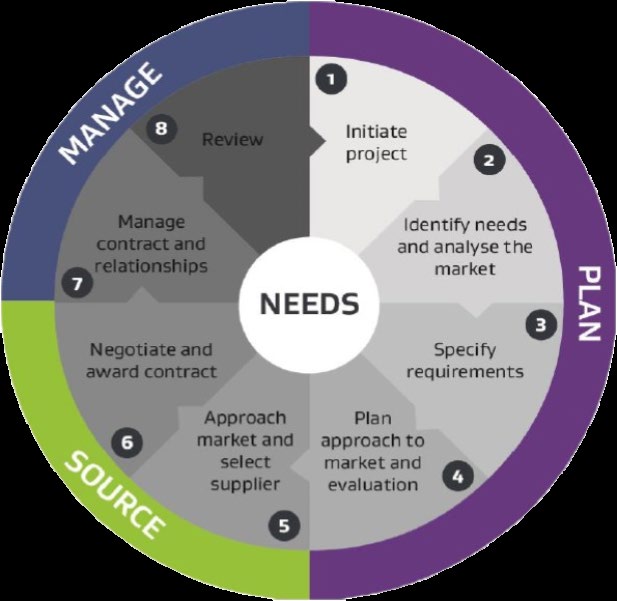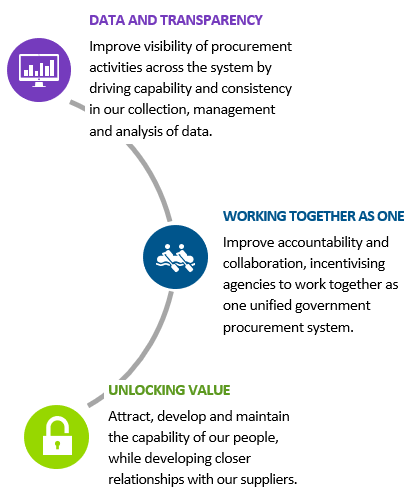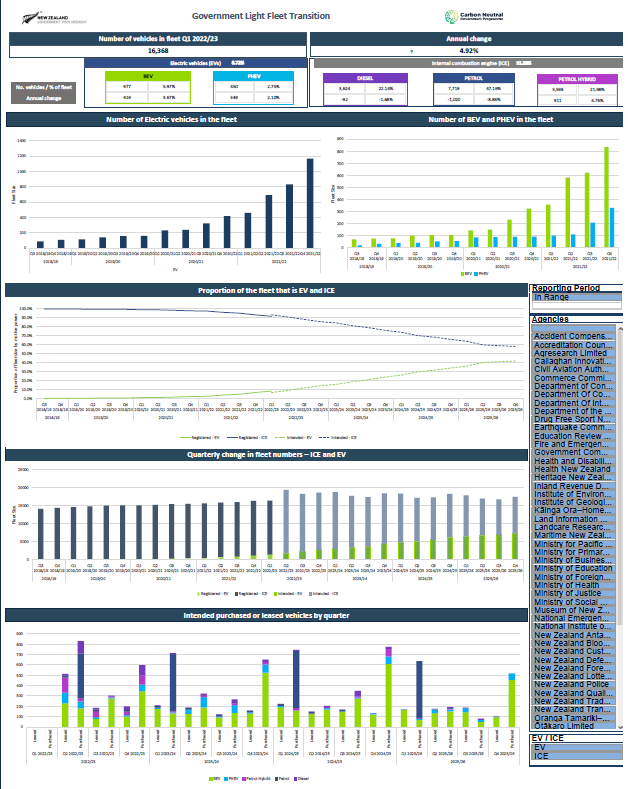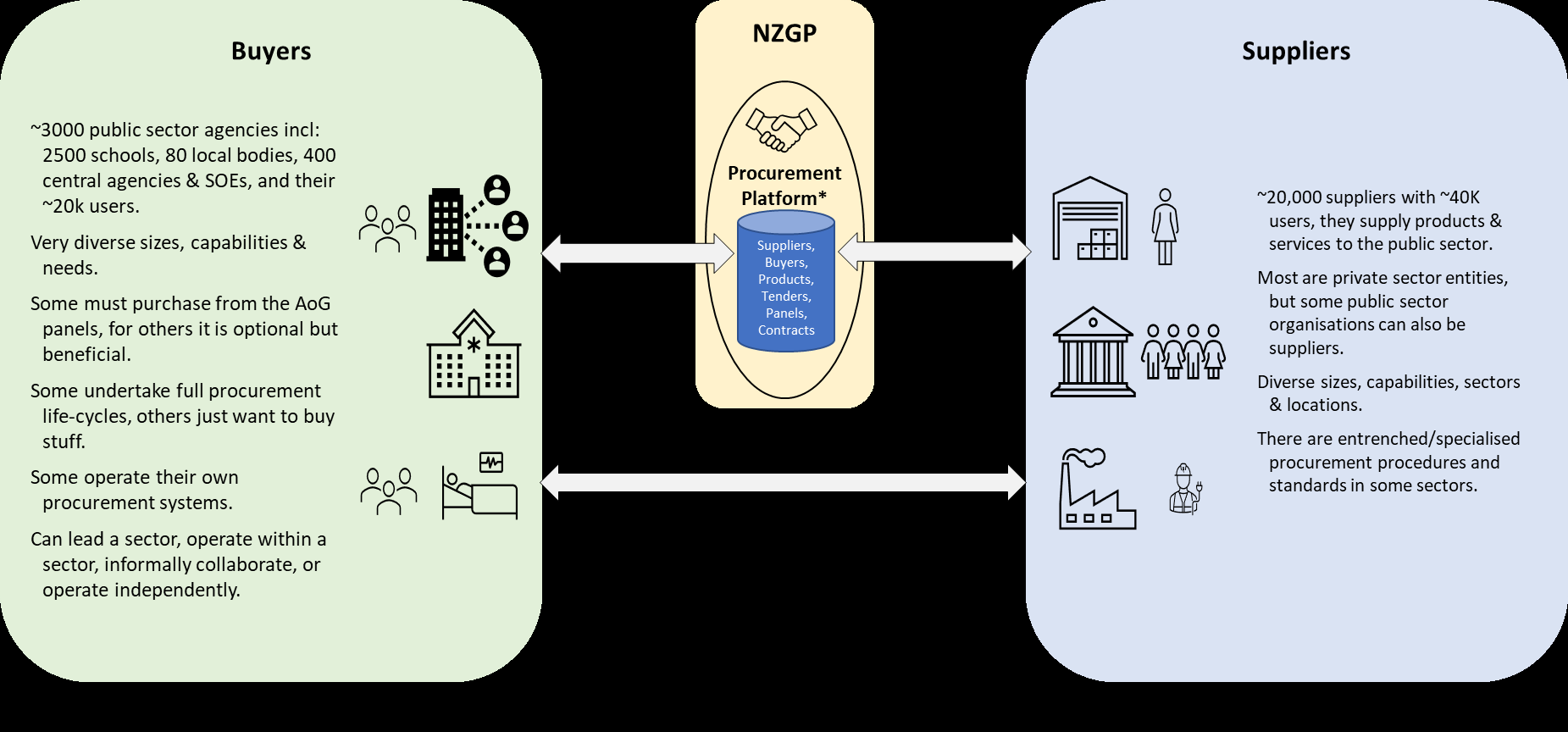 COVER BRIEFING
COVER BRIEFING
Discussion on government procurement
Date:
1 December 2023
Priority:
Medium
Security
In Confidence
Tracking
2324-1143
classification:
number:
Action sought
Action sought
Deadline
Hon Melissa Lee
Note the contents of the attached
4 December 2023
Minister for Economic
slides for your discussion with MBIE
Development
officials on Monday, 4 December
2023
Contact for telephone discussion (if required)
Name
Position
Telephone
1st contact
General Manager, New
Laurence Pidcock
Zealand Government
s 9(2)(a)
Procurement
Head of Strategy, Policy
Richard Lee
and Governance, New
s 9(2)(a)
Zealand Government
Procurement
Policy Manager, New
Coreen Adamson
Zealand Government
s 9(2)(a)
Procurement
The fol owing departments/agencies have been consulted
Released under the
Minister’s office to complete:
Approved
Declined
Noted
Needs change
Seen
Overtaken by Events
Official Information Act 1982
See Minister’s Notes
Withdrawn
Comments

 COVER BRIEFING
COVER BRIEFING
Discussion on government procurement
Date:
1 December 2023
Priority:
Medium
Security
In Confidence
Tracking
2324-1143
classification:
number:
Purpose
This briefing provides you with further information on government procurement to inform your
discussions with the officials from the Ministry of Business, Innovation and Employment at your
upcoming officials meeting on 4 December 2023.
Recommended action
The Ministry of Business, Innovation and Employment recommends that you:
a
Note the contents of the attached slides for your discussion with officials from the Ministry of
Business, Innovation and Employment on at your officials meeting on Monday, 4 December
2023.
Noted
Released under the
Laurence Pidcock
Hon Melissa Lee
General Manager, New Zealand
Minister for Economic Development
Government Procurement, Building and
Resource Markets, MBIE
..... / ...... / ......
1/12/2023
Official Information Act 1982
2324-1143
In Confidence
1
Background
1.
On Monday, 27 November 2023, you received the Briefing for the Incoming Minister (BIM)
for Economic Development, which outlined your portfolio responsibilities. As part of this
portfolio, you have responsibility for government procurement. The attached slide pack
provides more information on the government procurement.
Key points
2.
The information in the slide pack provides you with an overview of government
procurement and key initiatives that can support your priorities. Some key points are:
a.
Procurement is a strategic enabler to maximise public value from any government
expenditure through third parties.
b.
You (and Cabinet) have responsibility for setting the strategic objectives and priorities
for the procurement system and aligning them to the Government’s wider goals.
c.
This is done through a framework of central system-level leadership, Procurement
Rules, and guidance.
d.
There is a limit to the number of government objectives that the system can achieve in
ways that do not increase cost and make sense to markets and suppliers.
e.
There are opportunities to deliver greater efficiencies and reduce bureaucracy and red
tape through the procurement system, particularly through system improvements in
technology, capability, and motivating agency collaboration.
f.
NZGP directly manages 19 Al -of-Government (AoG) contracts that cover a range of
common goods and services, totalling around $3 bil ion annually. Established under the
Government Better Public Services reforms in 2009/10, this programme achieves cost
savings and efficiencies from agencies’ purchases through it. Recent savings amount
to $200 mil ion in 2022/23. This is an eight-fold return on investment from funding
NZGP receives (approximately $26 mil ion per year, the majority from agency level
funding through AoG contracts).
Annexes Released under the
Annex One: Government Procurement summary slides
Official Information Act 1982
2324-1143
In Confidence
2
Annex One: Government Procurement summary slides
Released under the
Official Information Act 1982
2324-1143
In Confidence
3

 Government Procurement
Government Procurement
Summary for the Minister for Economic
Development
1 December 2023
Laurence Pidcock, General Manager, New Zealand Government Procurement
Released under the
Official Information Act 1982
Government spends ~$51b p.a. on goods and services with third
party suppliers
• To deliver public services to New Zealand within fiscal boundaries, it is critical the Government
maximise value from any expenditure with third party suppliers
• Highly devolved Public Service. Individual agencies make purchase decisions
• Government sets expectations to influence and impact these decisions via:
• Procurement Rules
• Guidance
• $3 bil ion of common goods and services annually managed through central MBIE contracts
• Savings of $200 mil ion achieved through these contracts in FY 2022/23
• Expectations are tiered:
• ~140 “mandated” agencies must apply Rules
• CRIs expected to apply Rules
• ~3,000 agencies encouraged to apply Rules (incl. schools, state-owned enterprises and councils)
• System Leader (MBIE) oversees whole-system procurement performance. To better coordinate across
Released under the
govt, there are 7 system leads, incl. 3 most mature: Procurement, Digital and Property
Official Information Act 1982
 Finding and unlocking value – where is it?
Value in procurement is across every part of the cycle
Finding and unlocking value – where is it?
Value in procurement is across every part of the cycle
Not just tendering and negotiating
Also: deciding what to buy, how and who from:
•
Business need: Is procurement the best solution?
•
Plan: Understand the market, plan strategical y
•
Source: Best way of approaching market (not auto-tender)
•
Manage: Actively work with suppliers to maximise value
Not just what we buy, but who we buy from and how
we buy from them can accelerate opportunities to
deliver government priorities
Released under the
Official Information Act 1982
 How is procurement currently performing?
How is procurement currently performing?
Procurement is delivering value, but can deliver more
Internationally NZ’s procurement system is highly regarded…
•
Integrity – The system-as-whole is (relatively) transparent and fair
•
Your priorities – System can incorporate changes in government priorities
•
Not overly prescriptive – Rules-based but allows for sound commercial
decisions to be made
Chal enges… there are improvements needed in three critical areas:
•
Data and transparency – Aggregate easy-to-access data – what is being
purchased; at what cost; who is buying; who is supplying; benefits realised
•
Working together – Active co-ordination of agency purchases where there
are benefits – government as “single smart purchaser”
•
Capability and value – Simplifying practices managed by capable
procurement personnel and supported by specialist expertise
Released under the
This is mostly about changing behaviour (not investment)
Official Information Act 1982
 What wil drive these improvements?
What wil drive these improvements?
NZ’s procurement system is transforming
•
Transparency: Shining the light on comparative performance
wil accelerate changes in behaviour
•
Insights: Ability for all players to identify trends and risks will
reveal opportunities and lift capability
•
System Leadership: Ability to actively monitor performance at
agency, sector and whole-system level will improve accountability
System improvement initiatives:
• Rolling out a common eProcurement platform to al
agencies, including data standards
• Strengthening relationships with government’s strategic
(critical) suppliersReleased under the
• Expanding use of All-of-Government contracts
Official Information Act 1982
Delivering on your priorities – key trade-offs
Procurement can deliver (al kinds of) change – but at a cost
Recent areas of focus:
• Decarbonisation (uptake of EVs and lower carbon new builds)
• Social procurement (e.g., Progressive Procurement)
• Employment standards (e.g., pay the Living Wage for certain govt contracts)
• Managing national security risks
Limits to both
what and
how much procurement can do:
• Procurement isn’t always best lever – other levers sometimes better
• Suppliers understand priorities – but too many are confusing
• New initiatives come at a cost
There will be critical trade-offs to make when prioritising value for
Released under the
money vs additional priorities
Official Information Act 1982
To summarise:
• Effective management critical to extracting value from $51.5 bil ion p.a. public sector spend with third party
suppliers
• Procurement key lever to achieving this. You can choose the strategic focus for government procurement
• New Zealand Government Procurement, within MBIE, is mostly self-funded through agency levy on Al -of-
Government contracts
• Targeted work programmes for system improvement wil reduce red tape and realise efficiencies in
procurement system
Opportunities to realise efficiencies and savings:
1. Building a central Procurement Platform to get better data and visibility of what and from who
government is buying. Transparency of agency performance wil also accelerate changes in behaviour.
2. Leveraging Al of Government contracts to save government money ($200M in 2022/23 from central y
managed contracts with ~ $3 bil ion spend). We can advise on further opportunities to maximise value
from these contracts and prioritise cost savings and efficiencies.
3. Contractors and consultants - The Treasury and the Public Service Commission are preparing advice to
brief Ministers on reducing contractor and consultant expenditure (in addition to targeted baseline
Released under the
savings). Contractors and consultants are sourced through AoG contracts so MBIE can monitor individual
agency spend and help Treasury and PSC to drive accountability on expectations to reduce spending.
Official Information Act 1982
 BRIEFING
BRIEFING
New Zealand Government Procurement – supporting your priorities
Date:
21 December 2023
Priority:
Medium
Security
In Confidence
Tracking
2324-1416
classification:
number:
Action sought
Action sought
Deadline
Hon Melissa Lee
Note that government procurement can 23 January 2024
Minister for Economic be a powerful and effective lever for
Development
delivering government priorities
.
Direct NZGP to continue to seek savings
and efficiency gains from the Al -of-
Government contracts
and the
development of an end-to-end
procurement platform.
Discuss with officials the opportunities to
leverage government procurement to
deliver secondary outcomes through
procurement and other initiatives outlined
in this briefing
.
Contact for telephone discussion (if required)
Name
Position
Telephone
1st contact
Laurence Pidcock
General Manager, NZ
s 9(2)(a)
Government Procurement
Released under the
Head of Strategy, Policy and
Richard Lee
Governance, NZ
s 9(2)(a)
Government Procurement
The fol owing departments/agencies have been consulted
Minister’s office to complete:
Approved
Declined
Official Information Act 1982
Noted
Needs change
Seen
Overtaken by
See Minister’s Notes
Withdrawn

 BRIEFING
BRIEFING
New Zealand Government Procurement – supporting your priorities
Date:
21 December 2023
Priority:
Medium
Security
In Confidence
Tracking
2324-1416
classification:
number:
Purpose
On 27 November 2023, you received the Briefing for the Incoming Minister (BIM) for
Economic Development, which outlined your portfolio responsibilities, including high level
information about government procurement. This briefing provides you with further
information on government procurement and invites you to discuss opportunities with New
Zealand Government Procurement (NZGP) officials from the Ministry of Business,
Innovation and Employment.
Recommended action
The Ministry of Business, Innovation and Employment recommends that you:
a
Note that government procurement can be a powerful and effective lever for delivering
government priorities.
Noted
b
Direct NZGP to continue to seek savings and efficiency gains from the Al -of-
Government contracts and the development of an end-to-end procurement platform.
c
Discuss with officials the opportunities to leverage government procurement to deliver
secondary outcomes through procurement and other initiatives outlined in this briefing.
Yes / No
Released under the
Laurence Pidcock
General Manager, New Zealand
Hon Melissa Lee
Government Procurement, MBIE
Minister for Economic
Development
21/ 12 / 2023
..... / ...... / ......
Official Information Act 1982
2324-1416
In Confidence
1
Introduction
1. The New Zealand public sector spends around $51.5 bil ion1 each year on purchases
of goods and services from suppliers to support the delivery of its activities, including
infrastructure, social and other public services, and routine and specialised goods
and services. Government procurement spend is 17% of GDP and has a huge impact
on the New Zealand economy.
2. Disciplined management of this spend is critical to maximising value and ensuring
that procurement activities align with and contribute to the government’s priorities,
including spending public money carefully and with a clear purpose.
3. As Minister for Economic Development, you are the Minister responsible for
government procurement policy settings. The Chief Executive of the Ministry of
Business, Innovation and Employment (MBIE) is the System Lead for procurement
and oversees the whole-of-system performance. New Zealand Government
Procurement (NZGP), a branch within MBIE, is responsible for implementing the
government’s procurement priorities.
4. This briefing provides you with information on the government procurement system,
opportunities, and details of the work of NZGP. It seeks your confirmation to continue
work on initiatives to achieve savings; efficiencies; reduce red tape and bureaucracy;
and align procurement to the government’s priorities.
Overview of Government Procurement
5. The New Zealand public sector spends around $51.5 bil ion each year on purchases
of goods and services from suppliers to support the delivery of its activities. An
overview of the government’s largest categories of spend is set out in Annex One.
What does procurement activity cover?
6. Good procurement covers the critical analysis of an agency’s needs, understanding
the market capability and capacity, and implementing a robust sourcing, contract, and
supplier relationship management strategy:
•
Planning: includes identifying business needs and outcomes sought; putting in
Released under the
place the right governance and management frameworks and planning the
approach to market.
•
Sourcing: includes approaching the market and evaluating suppliers; selecting the
right one; and negotiating and awarding the contract.
•
Managing: includes ensuring that the procurement activity delivers the outcomes
sought, and consistently managing the contract and supplier relationship(s) to
derive maximum value.
Official Information Act 1982
1 This figure was last calculated by Statistics New Zealand in 2019 as an estimate of
annual spend by the public sector. It wil be updated in 2024 and we anticipate a material
increase.
2324-1416
In Confidence
2
Setting the direction and outcomes for procurement
7. New Zealand’s Public Service chief executives have autonomy over how their
departments operate, including accountability for their procurement. The breadth of
both the type and volume of spend means that agencies need to remain primarily
responsible for what they purchase. However, they must do this within the
government’s procurement framework made up of policy, Government Procurement
Rules, and guidance.
8. You (and Cabinet) have responsibility for setting the strategic objectives for the
government procurement framework.
9. The Chief Executive of MBIE is responsible, as the Procurement System Leader2, for
leading and co-ordinating government procurement best practice and supporting the
Minister for Economic Development to drive the Government’s strategic objectives for
procurement. Their mandate enables them to do this by:
• directing agencies to use system-wide frameworks and arrangements (e.g., All of
Government contracts, systems, and practices);
• lifting procurement capability (e.g., setting core competencies and practice
expectations);
• establishing outcome measures and monitoring system performance;
• identifying areas of agency under-performance and requiring remedial actions;
and
• facilitating and coordinating cross-agency collaboration across the government
procurement system.
Opportunities for government procurement
Opportunity 1: Continue to seek savings and efficiencies from All-of-Government
Contracts
10. Established under the Government Better Public Services reforms in 2009/10, the Al -
of-Government (AoG) contracts achieve cost savings and efficiencies from agencies
that purchase through it. Annual savings amounted to over $200 mil ion in 2022/23.
Released under the
11. NZGP centrally manages 19 AoG contracts. These cover a range of common goods
and services such as recruitment, contractors and consultants, office supplies,
electricity, reticulated gas, motor vehicles, air travel, consultancy services, banking,
external legal services.
12. AoG contracts:
• save agencies (and the Government as a whole) money by leveraging our
Official Information Act 1982
collective purchasing power and avoiding duplication;
• drive efficiencies for government and suppliers through standardised processes
and effective supplier relationship management;
• improve service quality for both government and suppliers.
2 Designated by the Public Service Commissioner under the Public Service Act 2020.
2324-1416
In Confidence
3
13. To derive greater value from AoG contracts, NZGP is developing work programmes
to:
• ensure an uptake in participation and utilisation of these contracts by more public
sector agencies;
• focus on seeking value for money when returning to market for expiring contracts
and less on non-commercial outcomes;
• manage supplier performance to realise additional benefits and reduce normal
contract value erosion; and
• monitor and manage agency spend from AoG contracts, in particular, on
contractors and consultants.
Opportunity 2: Leverage procurement to contribute to economic, environmental,
and social outcomes – update as necessary to align with government priorities
14. In recent times, governments globally have sought to deliver secondary outcomes,
(i.e., economic, environmental, and social outcomes) through procurement in addition
to the goods and services being purchased. New Zealand has also adopted this
approach. You are able to make strategic choices about how the procurement
framework (including the Rules) gives effect and contributes to the Government’s
wider priorities. This includes considering how existing policies may be refocussed or
developed to align with them.
15. Some
initiatives introduced over the last three years supporting economic,
environmental, and social outcomes included:
• Employment standards: ensuring a living wage for cleaning, catering, and security
guard services in government contracts;
• Progressive procurement: focus on increasing the diversity of suppliers;
• Decarbonisation of the public sector: requiring agencies to transition light fleet
vehicles to electric vehicles; and requiring the use of building rating systems (such
as Green Star) when constructing certain types of government buildings.
16. While procurement can be a lever to impact economic, social, and environmental
change, there are limits to both what and how much procurement can do. The
Released under the
number of government objectives that the system can achieve in ways that makes
sense to markets and suppliers is limited by the ease with which they can be applied
and the benefits that can be realised.
17. You may be asked to consider using procurement to contribute to the portfolio
priorities of your ministerial colleagues, through secondary outcomes, from time to
time. We wil support you with advice, which wil take into account the opportunities
and risks associated with the above.
Official Information Act 1982
There are two commitments in the coalition agreements that are seeking secondary
outcomes through procurement…
18. The commitment in the ACT/National coalition agreement to award contracts “based
on value, without racial discrimination”. We understand that Cabinet has invited the
Minister for the Public Service to report back s 9(2)(f)(iv)
2324-1416
In Confidence
4
s 9(2)(f)(iv)
We wil support
you in any ministerial consultation and engagement required.
19. The NZ First/National coalition agreement has a commitment to “direct agencies
where practical and appropriate to preference the use of woollen fibres rather than
artificial fibres in government buildings.” The Rules require agencies to seek value for
money and are materials agnostic for this reason. NZGP (in conjunction with the
Ministry for Primary Industries) has guidance in place that encourages agencies,
where appropriate, to use wool in the construction of government buildings.
20. We wil engage with you about these commitments in early 2024.
Opportunity 3: Government Procurement Rules – update as necessary to align with
government priorities
21. The Rules govern the way agencies procure goods, services, and works in
accordance with good procurement practice.
22. The Rules:
• promote accountability for the appropriate use of public money;
• require agencies to get value, this is the primary objective;
• ensure the system operates with integrity, including transparency, fairness, and
competition;
• reflect New Zealand’s trade obligations; and
• establish procurement processes that are consistent and predictable, making it
easier for agencies and suppliers to engage with each other.
23. The Rules are mandatory for Departments, Ministries, Crown Entities and Public
Finance Act Schedule 4A companies (often referred to as “mandated agencies”) –
approximately 140 agencies. Al other government agencies (including School
Boards of Trustees, Universities, State-Owned Enterprises, and local government)
are either expected or encouraged to apply the Rules as a matter of good
procurement practice.
24. New Zealand’s government procurement system is well regarded internationally, and
Released under the
New Zealand’s Procurement Rules are some of the most flexible of our trade
partners and comparable jurisdictions. This has co-benefits for government and
business in that they allow for commercial pragmatism and are not overly focussed
on compliance. However, the commercial capability, risk appetite and procurement
practice of the public sector needs to lift in order to realise more value from them.
25. The current edition of the Rules came into effect in 2019. We are planning to
undertake a review of them in 2024 to ensure they remain fit for purpose, reflect
modern approaches, and drive good procurement practice. As an example, there has
Official Information Act 1982
been an increase in use of non-traditional, but competitive and transparent,
procurement methods that are realising value and reducing the costs of doing
business, which should be reflected in the Rules to give government buyers and
business confidence to us them.
26. This review wil give you the opportunity to ensure the Rules reflect the government’s
priorities for procurement. We will engage with you on the Rules review in March /
April 2024.
2324-1416
In Confidence
5
System improvements 27. There are opportunities to deliver greater efficiencies and reduce bureaucracy and
red tape through the procurement system, particularly through digital systems,
insights from data, motivating agency collaboration and capability development.
28. We have programmes of work aligned to realise opportunities for system
improvement over the medium to long term. Industry leaders have provided input into
the development of this system improvement programme, and we engage with them
regularly for feedback. Some key initiatives are:
Opportunity 4: Procurement Platform – continue to progress savings and
efficiencies from technology and automation
29. The problem: Government is the largest buyer in New Zealand, accounting for more
than $51.5 bil ion of annual spend, approximately 17% of New Zealand’s GDP. Yet,
there is no centralised view of this spend. This limits the government’s ability to track
and measure how well spend with suppliers to deliver public services is performing.
30. The solution: A central end-to-end procurement platform (the Procurement Platform).
This is an ambitious but achievable vision that wil deliver positive fiscal outcomes,
improve transparency, efficiency, and better manage and influence government
spend. A high-level overview of its function and benefits is in Annex Two.
31. Al funding for this project and ongoing operation is fully set aside and budgeted for
from the collection of fees from agencies for use of AoG contracts.
32. The Procurement Platform wil be delivered in phases (Phase 1 and Future Phases)
and we wil provide you with regular updates on our plans, milestones met and
realised benefits.
Phase 1 – delivery in 2024
33. Phase 1 of the Procurement Platform wil enable NZGP to target initiatives in all-of-
government contracts to deliver an additional $108m per year in cost savings across
all user government agencies.
34. Once the Procurement Platform is launched in September 2024, fiscal benefits wil be
Released under the
realised incrementally from this date.
35. Phase 1 of the Procurement Platform wil provide a single system for AoG contracts
(and similar contracts for use by many agencies) that wil provide central oversight,
monitoring and transparency over all spend that goes through it.
36. The government will have the ability to effectively monitor agency behaviour and
drive accountability on any government expectations. For example, monitor the
spend on consultants and contractors by individual agencies.
Official Information Act 1982
Future phases of the Procurement Platform
37. Phase 1 lays the foundation for further development of the Procurement Platform to
gain further transparency across government third-party spend. It will realise even
greater fiscal benefits and drive accountability on the investment and spend by all
government agencies.
2324-1416
In Confidence
6
38. Through this improved visibility of spend, NZGP can identify future commercial
opportunities to achieve savings and efficiencies as well as better monitor whole of
system performance. NZGP wil be able to use data and insights to reveal trends and
identify more opportunities to lift capability, promote continuous improvement and
drive accountability for good procurement practices.
Opportunity 5: Sector leadership – continue to seek efficiencies from sector-based
collaboration, starting with supporting the establishment of the National
Infrastructure Agency
39. Due to individual agency silos which prevent the government from working together
as a smart, unified client of choice, aspects of the current system are not realising
their full potential. This can, for example, result in government competing against
itself for the same suppliers, spreading market capacity and specialist procurement
expertise too thin, and limiting the impact public spending can have on delivery. We
have been developing a framework for ‘sector leadership’ to address these issues,
with an initial focus on infrastructure.
40. The Government’s 100-day plan includes beginning to establish a National
Infrastructure Agency to coordinate government funding, connect investors with New
Zealand infrastructure, and improve funding, procurement, and delivery.
41. s 9(2)(f)(iv)
Opportunity 6: Capability development – underpins performance of the procurement
system and is ongoing
42. A procurement system that is performing well must have good procurement capability
and capacity. Currently there are procurement skil shortages across the New
Zealand Government. NZGP has a work programme to raise the capability of
individuals and government agencies.
43. This work includes future procurement workforce planning that is responsive and
keeps pace with technology and changes to ways of working.
Released under the
44. The Procurement Graduate Programme is an ongoing initiative that is strengthening
the procurement workforce. Since it launched in 2014, there have been 81
graduates.
Funding
45. NZGP’s funding comes from two main sources:
Official Information Act 1982
• An administration fee charged on the purchases made by government agencies
from the AoG contracts, around $22 mil ion per year; and
• Crown funding, around $5 mil ion per year.
46. From this funding, we achieved an eight-fold return on investment by delivering over
$200 mil ion in savings from the AoG contracts in 2022/23 than would otherwise have
been achieved. Ef iciency gains are realised by managing the contracts centrally to
2324-1416
In Confidence
7
achieve co-benefits for suppliers and government, including avoiding duplication, and
ensuring effective supplier relationship management to drive performance, delivery,
and value over the life of the contracts.
Next steps
47. We wil coordinate with your office on a suitable time in early 2024 for officials to
discuss opportunities for government procurement with you.
Annexes
Annex One: Government spend profile
Annex Two: Procurement Platform
Released under the
Official Information Act 1982
2324-1416
In Confidence
8
































 Annex One: Government spend profile
Other ($9.5b)
Property ($0.5b)
All agencies
All agencies
Annex One: Government spend profile
Other ($9.5b)
Property ($0.5b)
All agencies
All agencies
Breakdown not known (data not available) includes:
• Leadership: Property System Leader (MBIE)
• Specialist goods/services cri�cal to agency delivery
• Fully centralised delivery of office accommoda�on
• Asset purchases (e.g. Defence, Police)
services
• Health (e.g. pharmaceu�cals, medical equipment)
• Con�nuing work on implementa�on (funding, HR,
• Educa�on (e.g. social workers in schools)
legal, etc.)
• Research (e.g. purchase from CRIs)
• System leader role: oversee and directly manage
System leader role: Support procurement best prac�ce,
purchase, delivery and management of office
li� generic procurement capability
accommoda�on
$0.5b
Property
AoG ($3b)
Social ($12b)
All agencies
Health, educa�on, social services, etc
• Leadership: NZ Government Procurement (NZGP)
$10b
$12b
• Leadership: Social services sector commissioning
• Centrally nego�ated contracts for common goods and
Other
Social
(MSD)
services
• Rela�vely advanced interagency collabora�on and
• Poten�al to grow through:
$3b AoG
accountability
(a) more agencies using exis�ng contracts and
• Strong use of alterna�ve procurement approaches
(b) new areas of common spend
$8b
(e.g. outcomes based, rela�onal contrac�ng)
• Focus: Be�er public value and procurement efficiency
ICT
• System leader role: Social services procurement
• System leader role: Grow AoG procurement
$18b
competency framework; support best prac�ce,
Infrastructure
collabora�on, li� social services procurement
capability
Infrastructure ($18b)
Released under the
Homes and Communi�es (Kāinga Ora), NZ Transport
Agency (Waka Kotahi), Defence, Educa�on, Correc�ons,
ICT ($8b)
etc.
All agencies
Key sector players, roles being recalibrated:
• Leadership: Digital System Leader (GCDO)
• NZ Infrastructure Commission (Te Waihanga)
• Focus: Standards, pipeline and coordina�on of IT
• Rua Paenga
investment
Focus: Pipeline visibility, delivery oversight, sector
• All-of-Government spend is approx. 20% of total spend
engagement
• System leader role: Suppor�ng best prac�ce,
System leader role: Suppor�ng best prac�ce,
collabora�on, li� ICT procurement capability
Official Information Act 1982
collabora�on, li� infrastructure procurement capability
2324-1416
In Confidence
9
 Annex Two: Procurement Platform
Annex Two: Procurement Platform
Released under the
Official Information Act 1982
2324-1416
In Confidence
10
 BRIEFING
New Zealand Government Procurement – All-of-Government contract
BRIEFING
New Zealand Government Procurement – All-of-Government contract
update
Date:
2 February 2024
Priority:
Medium
Security
In Confidence
Tracking
2324-1769
classification:
number:
Action sought
Action sought
Deadline
Hon Melissa Lee
Note that NZGP will demonstrate
19 February 2024
Minister for Economic leadership and give effect to the
Development
Government’s expectation to achieve
value for money through the All-of-
Government contracts.
Note that NZGP officials are returning to
market late-February with the Creative
and Media Services contract, which will
focus on value for money.
Agree that NZGP keeps you informed on
the All-of-Government contracts and on
savings, value for money and efficiencies
achieved through them.
Note that NZGP is proactively
communicating to agencies the
Government’s expectations of fiscal
discipline, responsible spending and
achieving value for money.
Released under the
Contact for telephone discussion (if required)
Name
Position
Telephone
1st contact
Laurence Pidcock
General Manager, NZGP
s 9(2)(a)
✓
Head of Strategy, Policy and
Richard Lee
s 9(2)(a)
-
Governance, NZGP
Official Information Act 1982
Head of Collaborative
Tim Sherborne
s 9(2)(a)
-
Procurement, NZGP
Fraser Pearce
Principal Policy Advisor, NZGP
s 9(2)(a)
-
The following departments/agencies have been consulted

 BRIEFING
New Zealand Government Procurement – All-of-Government contract
BRIEFING
New Zealand Government Procurement – All-of-Government contract
update
Date:
2 February 2024
Priority:
Medium
Security
In Confidence
Tracking
2324-1769
classification:
number:
Purpose
This briefing informs you about the All-of-Government contracts, upcoming Creative and
Media Services contract return to market and its focus on value for money to align with
government’s expectations. New Zealand Government Procurement (NZGP) is also
proactively communicating to agencies the Government’s expectations of fiscal discipline,
responsible spending and achieving value for money.
Recommended action
The Ministry of Business, Innovation and Employment recommends that you:
a
Note that NZGP will demonstrate leadership and give effect to the Government’s
expectation to achieve value for money through the All-of-Government contracts.
b
Note that NZGP officials are returning to market late-February with the Creative and
Media Services contract, which will focus on value for money.
Noted
c
Agree that NZGP keeps you informed on the All-of-Government contracts returning to
market this year and on savings, value for money and efficiencies achieved through
them.
Yes / No
d
Note that NZGP is proactively communicating to agencies the Government’s
expectations of fiscal discipline, responsible spending and achieving value for money.
Released under the
Noted
Laurence Pidcock
Hon Melissa Lee
General Manager, New Zealand
Minister for Economic
Official Information Act 1982
Government Procurement, MBIE
Development
2 / 2 / 2024
..... / ...... / ......
Background
1.
The New Zealand public sector spends around $51.5 billion each year on purchases
of goods and services from providers to support the delivery of its activities.
Approximately $3 billion of this spend is through the All-of-Government (AoG)
contracts.
Your role in the government procurement system
2.
As Minister for Economic Development, you are responsible for government
procurement policy settings. New Zealand Government Procurement (NZGP), a
branch within MBIE, is responsible for implementing the Government’s procurement
priorities. This includes developing, negotiating, managing, monitoring and reporting
on AoG contracts.
All-of-Government contracts
3.
Established under the Government Better Public Services reforms in 2009/10, the
AoG contracts achieve cost savings and efficiencies from agencies that purchase
through it. Annual savings amounted to over $200 million in 2022/23.
4.
NZGP centrally manages 19 AoG contracts. These cover a range of common goods
and services such as recruitment, contractors and consultants, office supplies,
electricity, reticulated gas, motor vehicles, air travel, consultancy services, banking,
external legal services.
Annex one (attached) provides further information on the 19
AoG contracts. There are over 1100 government agencies that purchase goods and
services through them. Benefits include:
• saving agencies (and the Government as a whole) money by leveraging our
collective purchasing power and avoiding duplication;
• driving efficiencies for government and suppliers through standardised processes
and effective supplier relationship management; and
• improving service quality for both government and suppliers.
New Creative and Media Services AoG contract
Released under the
5.
We are ready to go to market for the Creative and Media Services (CMS) contract.
This contract replaces both the Design Services and Advertising Services AoG
contracts. This is because both contracts cover similar and complementary services,
and some providers are signed up to both AoG contracts. Making this change
simplifies administrative processes and costs to service providers, government
agencies and NZGP. It also better reflects the nature of the services purchased by
agencies.
Official Information Act 1982
6.
173 providers currently use the Design Services and/or Advertising Services
contracts, and 206 agencies use the AoG contracts. Agency spend on both AoG
contracts is approximately $57 million each year, s 9(2)(j)
7.
We have ensured the CMS tender documentation will communicate the
Government’s expectation on achieving value for money. Providers will need to
publish to agencies the market hourly rate (and the AoG discount) they will charge for
services. Providers can also publish other payment methods that agencies can use,
including setting fixed costs for outcomes or phased services, subscriptions, and
innovative ‘partnership’ models.
8.
These changes will allow agencies to better assess the costs and benefits of different
providers. It will also streamline agency efforts to establish bespoke arrangements
with providers, should the situation require it.
9.
New Zealand has adopted international good practice to consider sustainable
procurement and other public benefits, where relevant. These are reflected in the
Government Procurement Rules as
Broader Outcomes. This enables the
Government to deliver further public benefits that align to their priorities beyond the
immediate good or service being purchased.
10. To increase the value that can be derived from the CMS contract, we are including
an objective to improve opportunities for New Zealand businesses to work with
government agencies.
11.
Annex two (attached) sets out the objectives and expected outcomes of the new
CMS contract for your information. It also includes information on the Design and
Advertising Services contracts, which are expiring in June 2024.
Next steps
Communicating the Government’s expectations on fiscal sustainability
12. Procurement is a strong lever for delivering fiscal benefits. To support the
Government’s fiscal sustainability expectations more broadly, we are communicating
that agencies must exercise discipline, responsible spending and achieve value for
money when undertaking procurement activity. This includes direct communications
to agencies’ Chief Procurement Officers and ongoing engagement through our
advisory services to agencies.
We intend to go to market in Late February 2024 with the CMS contract
Released under the
13. The CMS contract is open tender – any provider can submit a proposal to deliver
services under the CMS contract. The tender for the CMS contract will close around
25 days after it has been released. The new contract will be in place prior to the two
AoG contracts expiring in June 2024.
14. We do not expect your office will receive significant media interest regarding NZGP
going to market for the CMS contract. Some interest may be possible as the contract
covers advertising services. We can support your office to answer any media queries.
Official Information Act 1982
Annexes
Annex one: Summary of All-of-Government contracts managed by NZGP
Annex two: Further information on the Creative Media Services (CMS) All-of-Government
contract
Annex one: Summary of All-of-Government contracts managed by NZGP
All-of-Government Contracts
Contract name
Description
Approximate
spend
136 providers offer client services, creative and
$49 M
Advertising
production, and media services across print,
services
broadcast, digital, out-of-home, and emerging
media.
12 air travel services suppliers representing 15
$189 M
Air travel
airlines offer agencies both domestic and
services
international flights.
A panel of four banking providers covering
$20 M
banking services, foreign exchange services,
payment services, and card services.
Transactional banking services are also
Banking services available to non-core agencies.
Westpac is the sole government banker under
the Public Finance Act appointed to provide
transactional banking services to the core
Public Service.
Professional services in works or construction,
$346 M
Construction
including 11 sub-categories across architecture,
consultancy
engineering, quantity surveying and project
services
management.
A panel of consultancy providers in 11 sub-
$484M
categories including accounting, business
Consultancy
change and marketing, and public relations.
services
Consultants are covered by this contract, but
Released under the
contractors are covered in the
Talent
Acquisition Services AoG.
84 providers offering design, strategy, and
$8 M
Design services
production, as well as project, account, and
relationship management services.
Covers the supply of electricity and associated
$233 M
Official Information Act 1982
services including:
• Fixed energy costs over the term of the
Electricity
supply agreed between the selected
supplier and agency.
• Flexible billing options, consolidated
billing, or individual billing for each site.
• Account management and reporting (if
needed) from the suppliers.
• A complaints or performance
management process and a timeline for
resolution.
30 providers of legal services in nine areas
$108 M
External legal
including banking and finance, employment,
services
and property law.
Facilities
Facilities management services providers of a
$1 M
management
range of management, technical and non-
services
technical services.
Includes a wide range of products such as
$174 M
desktop computers, laptops, monitors, mobile
IT hardware
phones, meeting room equipment and
associated services.
19 panel suppliers offering discounted
$30 M
advertising rates on television, radio, print,
digital, out-of-home, and cinema channels, with
Media
the ability to add emerging media.
It includes access to sources of added value
such as training opportunities and heavily
discounted airtime.
This panel provides fit-for-purpose, safe
$224 M
vehicles, including electric vehicles (EVs), at
Motor vehicles
the lowest possible total cost of ownership
across the life of the vehicle.
Offers agencies stationery, cleaning, hygiene
$67 M
and washroom consumables, ICT
Office supplies
consumables, educational supplies, health and
Released under the
safety products, and milk and milk alternatives.
Suppliers provide print equipment, print-related
$50 M
software, sector specific products like 3D
Print technology
printers, wide and large format printers, and
and associated
scanners; and related consultancy and
services
provider-enabled services, and maintenance
and servicing.
Official Information Act 1982
The AoG Rental vehicles contract includes
$14 M
general rentals, light commercial rentals and
less-than-one-day rentals.
Rental vehicles
The AoG supports the removal or reduction of
fees for airport-pick up, one-way hire, and
delivery.
This contract facilitates the supply of reticulated $46 M
gas to participating agencies at a competitive
Reticulated gas
market-aligned gas rate. Reticulated natural
gas is distributed via pipelines in the North
Island only.
Suppliers offer insurance management,
$170 M
advisory and broking services across 13
subcategories, ranging from motor vehicle and
international travel to personal accidents.
Risk financing
and insurance
This AoG supports competitive tension in the
industry, resulting in access to market-leading
commercial terms and conditions. It also
supports developing risk management maturity
across government.
Offers agencies specialist recruitment services
$224 M
from a panel of providers including for
permanent, temporary, and contractor
Talent
placement type roles in common administration
acquisition
and corporate, and common IT job families.
services
There is flexibility to negotiate prices directly
with providers if required and an annual cap on
provider fees.
Covers five nationwide travel management
$369 M
providers with services designed to meet
Travel
participating agencies' business travel
management
requirements.
services
It also includes a range of reporting options to
help analyse travel spend, and cost-reduction
expertise to help reduce travel spend over time.
Released under the
Official Information Act 1982
Annex two: Further information on the Creative Media Services (CMS) All-
of-Government contract
1.
Government represents the largest industry contributing to advertising spend in New
Zealand (Standard Media Index, 2022). The lifetime spend across both the
Advertising and Design services contracts is over $950m. The number of
participating agencies and spend is increasing year on year. Spend on advertising
service providers has increased by over 80 percent in the last five years.
2.
With fiscal responsibility, we expect that government spend on advertising services
will decrease. The contract will provide savings and efficiencies for when spend on
services is required.
3.
The table below sets out the draft objectives and anticipated outcomes for the CMS
contract.
CMS
Anticipated outcomes
objectives
Improve
• The solution promotes creative and media services through a
commercial
streamlined scope of services, meeting government agency needs.
value
• Improved commercial and pricing model to make savings through a
one-stop solution for government agencies.
• Improved competition through changes to panel structure and sharing
provider performance.
• Simpler user experience for government agencies to identify scope
and engage providers, including improvements to the service order.
• The solution enables consistency, efficiency, and transparency.
Improve
• Improved access to provider performance and relative pricing
category
comparison to better inform government agency buying decisions.
performance
• Pro-active support by NZGP to government agencies on addressing
secondary procurement needs including detailed guidance and
advice.
Released under the
Targeted
• The solution improves clarity on how intellectual and cultural IP will be
supplier
managed between providers and government agencies.
management
• The panel is more inclusive for New Zealand providers.
• The solution considers reducing carbon and waste emission
throughout the delivery of the services.
• Providers are aligned and delivering to the requirements of NZGP’s
Supplier Code of Conduct.
Official Information Act 1982















































